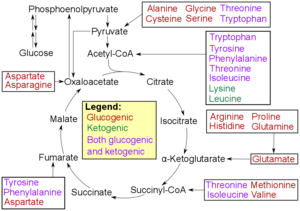Ketogenic amino acid

A ketogenic amino acid is an
ketone bodies and myelin, particularly during early childhood, when the developing brain requires high rates of myelin synthesis.[1] This is in contrast to the glucogenic amino acids, which are converted into glucose. Ketogenic amino acids are unable to be converted to glucose as both carbon atoms in the ketone body are ultimately degraded to carbon dioxide in the citric acid cycle
.
In humans, two amino acids – leucine and lysine – are exclusively ketogenic. Five more are amphibolic (both ketogenic and glucogenic): phenylalanine, isoleucine, threonine, tryptophan and tyrosine. The remaining thirteen are exclusively glucogenic.[2]
Studies
Ketogenic amino acids serve important roles in the human body, leading to the study of ketogenic amino acid rich (KAAR) diets as possible treatment for
amyloid precursor protein (APP). Rats that were fed a standard diet and an uptake of APP, leading to an increase in damaged/injured axons.[7]
See also
- Glucogenic amino acid
- List of standard amino acids
- Ketogenesis
- Metabolism
References
- PMID 17444813.
- ISBN 978-1-4641-2610-9. Archived from the originalon 2007-06-30.
- ^ PMID 20706589.
- PMID 13034849.
- S2CID 45289168.
- PMID 31898518.
- S2CID 231703455.
External links
- Amino acid metabolism
- Amino acid metabolism
 Media related to Ketogenic amino acids at Wikimedia Commons
Media related to Ketogenic amino acids at Wikimedia Commons

